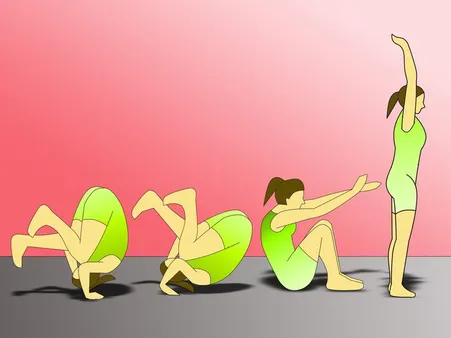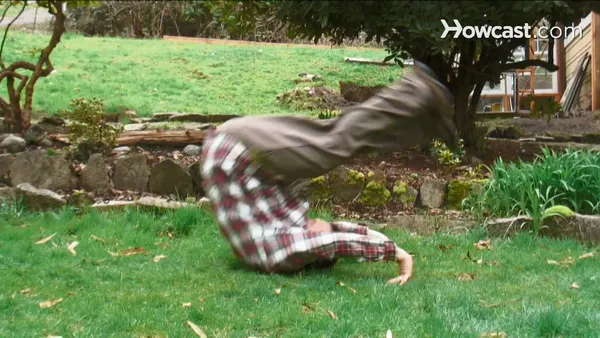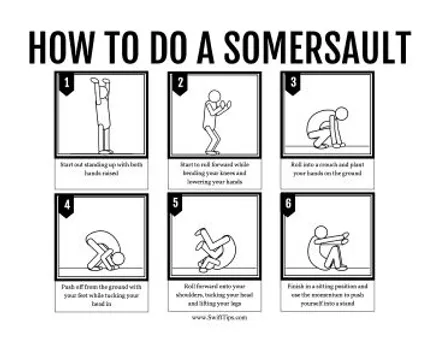Table of Contents
Have you ever wanted to learn How to do a somersault? This impressive gymnastic move is not only fun but also a great way to improve your coordination, balance, and body control. Whether you're a beginner or looking to perfect your technique, this comprehensive guide will take you through the steps of how to do a somersault safely and effectively. So, get ready to flip your way to fitness with Kizworld!
How to do a Somersault: A Step-by-Step Guide for Beginners
I. Develop Your Somersault Technique In 5 Simple Steps
Develop Your Somersault Technique In 5 Simple Steps
Safety First: Choose a Soft and Safe Surface
The gymnasium floor is typically mats and pads, but find a thick, soft surface to practice your somersault on. This will help reduce the risk of head injury and other injuries when you land.
Find a soft, safe surface to practice your somersault. Grass, sand, or a thick mat are all good options. Avoid practicing on concrete or asphalt, as these surfaces are too hard and can cause injury.
Step-by-Step Guide to Doing a Somersault
Step | Instruction |
|---|---|
1 | Start with a Forward Roll |
2 | Practice the Somersault |
3 | Perfect Your Somersault |
Practice the somersault regularly. The more you practice, the better you will become at it. You can start by practicing the forward roll and working your way up to the somersault.
Common Mistakes to Avoid When Doing a Somersault
- Not Tucking Your Chin
- Not Keeping Your Body Tight
- Not Landing Properly
Don't be afraid to ask for help from a coach or experienced gymnast. They can provide valuable tips and feedback to help you improve your technique.
II. Perfect Your Back Somersault With These 3 Tricks
Perfect Your Back Somersault With These 3 Tricks
1. Practice Backward Rolls
Before you try a back somersault, it's essential to master the backward roll. This will help you get the feeling of flipping backward and tucking your body into a ball. To do a backward roll, start by standing with your feet shoulder-width apart. Bend your knees and tuck your chin to your chest. Roll backward, keeping your body tight and your head tucked. Come up onto your feet and repeat.
See our detailed guide on how to do a backflip if you want to try one.
2. Practice Back Handsprings
Once you've mastered the backward roll, you can start practicing back handsprings. This will help you get the feeling of flipping backward and landing on your feet. To do a back handspring, start by standing with your feet shoulder-width apart and your arms raised overhead. Bend your knees and take a few steps forward. As you reach the end of your steps, jump up and tuck your knees to your chest. Push off the ground with your hands and flip backward. Keep your body tight and your head tucked. Land on your feet and repeat.
Check out our article on gymnast core exercises if you need to develop core strength.
3. Use a Spotter
When you're first learning how to do a back somersault, it's a good idea to use a spotter. A spotter can help you stay safe and prevent you from landing on your head. To use a spotter, stand with your back to the spotter and hold their hands. The spotter should stand behind you with their arms around your waist. As you flip backward, the spotter will help you land safely.
Start slowly and practice regularly. |
Get feedback from others. |
Don't be afraid to fall. |
III. Master the Forward Somersault: A Comprehensive Guide
Master the Forward Somersault: A Comprehensive Guide
The forward somersault, also known as a front flip, is a fundamental gymnastic move that requires coordination, balance, and body control. Whether you're a beginner or looking to improve your technique, this comprehensive guide will take you through the steps of how to do a forward somersault safely and effectively. So, get ready to flip your way to fitness with kizworld!
1. Warm Up
Before attempting a forward somersault, it's essential to warm up your body to prevent injuries. Start with some light cardio exercises, such as jogging or jumping jacks, to get your heart rate up. Then, stretch your muscles, focusing on your hamstrings, quadriceps, and shoulders. Check out our guide on how to warm up for exercise for more tips.
2. Find a Safe Place to Practice
Choose a safe and open area to practice your forward somersault. Make sure the ground is soft and free of obstacles. A gymnastics mat or a thick carpet can provide extra cushioning and reduce the risk of injury. If you're a beginner, it's best to practice under the supervision of a qualified instructor.
3. Start with a Forward Roll
To build confidence and get a feel for the movement, start with a forward roll. Stand with your feet shoulder-width apart and your arms at your sides. Bend your knees and tuck your chin to your chest. Roll forward, keeping your back straight and your arms tucked in. Once you've completed the roll, stand up and repeat the exercise.
4. Practice the Somersault
Once you've mastered the forward roll, you can start practicing the somersault. Stand with your feet shoulder-width apart and your arms at your sides. Take a few steps forward to gain momentum. As you approach the end of your steps, jump up and tuck your knees to your chest. Bring your arms forward and over your head, and tuck your chin to your chest. Keep your body tight and rotate forward, landing on your feet. Practice this movement slowly and gradually increase your speed as you become more comfortable.
5. Perfect Your Somersault
To perfect your somersault, focus on the following techniques:
- Keep your body tight and your muscles engaged throughout the movement.
- Tuck your chin to your chest to protect your neck.
- Bring your arms forward and over your head to generate momentum.
- Land softly on your feet with your knees slightly bent.
With practice, you'll be able to perform a forward somersault with ease and confidence.
Tips for Doing a Somersault
- Start slowly and gradually increase your speed as you become more comfortable.
- Practice regularly to improve your technique and build muscle memory.
- Get feedback from others to identify areas where you can improve.
- Don't be afraid to fall. Falling is a natural part of the learning process.
Common Mistakes to Avoid When Doing a Somersault
- Not warming up properly can lead to injuries.
- Trying to do a somersault too quickly can result in loss of control and injury.
- Not tucking your chin can cause neck pain or injury.
- Not keeping your body tight can lead to a sloppy and uncontrolled somersault.
- Not landing properly can cause ankle or knee injuries.
By following these tips and avoiding common mistakes, you can safely and effectively master the forward somersault.
IV. Related Posts
- The Benefits of Gymnastics for Kids
- The Best Gymnastics Equipment for Home Use
- How to Improve Your Flexibility and Mobility with Gymnastics
V. Tips and Tricks for a Perfect Somersault
Tips and Tricks for a Perfect Somersault
Mastering a somersault requires practice, technique, and a few helpful tips. Here are some tricks to enhance your somersault skills:
- Start Slowly: Begin with a forward roll to get a feel for the motion. Once you're comfortable, progress to a somersault.
- Tuck Tight: Keep your body tight and compact throughout the somersault. This helps maintain control and prevents injury.
- Spot Your Landing: Focus on a specific spot where you want to land. This helps you maintain balance and control as you come out of the somersault.
- Practice Regularly: Consistent practice is key to improving your somersault technique. Aim for regular practice sessions to build muscle memory and confidence.
- Get Feedback: Ask a coach, friend, or family member to observe your somersault and provide feedback. This can help you identify areas for improvement.
Mistake | Correction |
Not Warming Up | Always warm up before attempting a somersault to prevent injury. |
Trying to Do a Somersault Too Quickly | Start slowly and gradually increase your speed as you become more comfortable. |
Not Tucking Your Chin | Tuck your chin to protect your neck and avoid injury. |
Not Keeping Your Body Tight | Keep your body tight and compact throughout the somersault to maintain control. |
Not Landing Properly | Focus on a specific spot to land and maintain balance as you come out of the somersault. |
Remember, practice and patience are key to mastering a somersault. With dedication and the right techniques, you'll be flipping like a pro in no time! For more fitness tips and tricks, check out our related articles on gymnastics for kids and improving flexibility with gymnastics.
VI. Conclusion
With practice and dedication, you'll be able to master the somersault and impress your friends with your gymnastic skills. Remember to start slowly, practice regularly, and get feedback from others to improve your technique. Most importantly, have fun and enjoy the feeling of flipping through the air! For more fitness tips and tricks, be sure to visit kizworld.